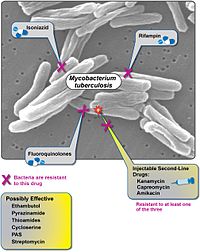
Back مرض السل الشديد المقاوم للعقاقير Arabic 광범위 약제내성 결핵 Korean Gruźlica XDR-TB Polish Tuberculose extensivamente resistente Portuguese Lao siêu kháng thuốc Vietnamese 广泛耐药结核 Chinese
| Extensively drug-resistant tuberculosis | |
|---|---|
 | |
| Description of extensively drug-resistant tuberculosis | |
| Specialty | Infectious diseases |
| Symptoms | The same as tuberculosis |
| Causes | Mycobacterium tuberculosis |
| Risk factors | Improperly treated tuberculosis |
Extensively drug-resistant tuberculosis (XDR-TB) is a form of tuberculosis caused by bacteria that are resistant to some of the most effective anti-TB drugs. XDR-TB strains have arisen after the mismanagement of individuals with multidrug-resistant TB (MDR-TB).
Almost one in four people in the world is infected with TB bacteria.[1] Only when the bacteria become active do people become ill with TB. Bacteria become active as a result of anything that can reduce the person's immunity, such as HIV, advancing age, or some medical conditions. TB can usually be treated with a course of four standard, or first-line, anti-TB drugs (i.e., isoniazid, rifampin and any fluoroquinolone). If these drugs are misused or mismanaged, multidrug-resistant TB (MDR-TB) can develop. MDR-TB takes longer to treat with second-line drugs (i.e., amikacin, kanamycin, or capreomycin), which are more expensive and have more side-effects. XDR-TB can develop when these second-line drugs are also misused or mismanaged and become ineffective. The World Health Organization (WHO) defines XDR-TB as MDR-TB that is resistant to at least one fluoroquinolone and a second-line injectable drug (amikacin, capreomycin, or kanamycin).[2]
XDR-TB raises concerns of a future TB epidemic with restricted treatment options, and jeopardizes the major gains made in TB control and progress on reducing TB deaths among people living with HIV/AIDS. It is therefore vital that TB control be managed properly and new tools developed to prevent, treat and diagnose the disease.
The true scale of XDR-TB is unknown as many countries lack the necessary equipment and capacity to accurately diagnose it. By June 2008, 49 countries had confirmed cases of XDR-TB.[3] By the end of 2017, 127 WHO Member States reported a total of 10,800 cases of XDR-TB, and 8.5% of cases of MDR-TB in 2017 were estimated to have been XDR-TB.[2]
In August 2019, the Food and Drug Administration (FDA) approved the use of pretomanid in combination with bedaquiline and linezolid for treating a limited and specific population of adult patients with extensively drug resistant, treatment-intolerant or nonresponsive multidrug resistant pulmonary TB.[4]
- ^ Houben, Rein M. G. J.; Dodd, Peter J. (25 October 2016). Metcalfe, John Z. (ed.). "The Global Burden of Latent Tuberculosis Infection: A Re-estimation Using Mathematical Modelling". PLOS Medicine. 13 (10): e1002152. doi:10.1371/journal.pmed.1002152. ISSN 1549-1676. PMC 5079585. PMID 27780211.
- ^ a b Cite error: The named reference
:0was invoked but never defined (see the help page). - ^ World Health Organization (2008). "Countries with XDR-TB confirmed cases as of June 2008" [1]
- ^ "FDA approves new drug for treatment-resistant forms of tuberculosis that affects the lungs" (Press release). Food and Drug Administration (FDA). 14 August 2019. Retrieved 18 August 2019.
- Lay summary in: "Scientists Discover New Cure for the Deadliest Strain of Tuberculosis". The New York Times. August 14, 2019.